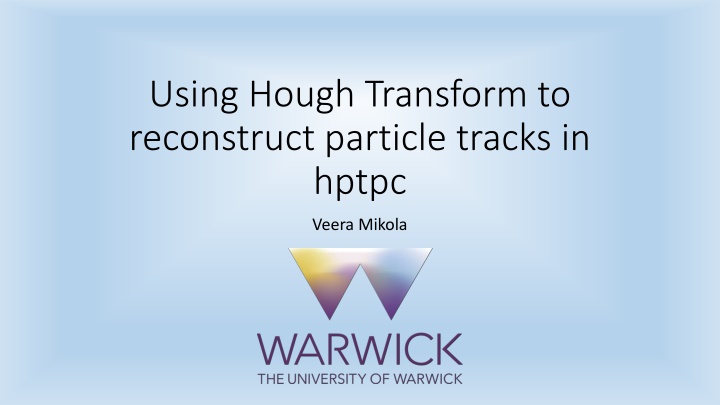
Advanced Particle Tracking Methods in HPTPC Research
Discover the innovative use of Hough Transform algorithm for reconstructing particle tracks in High-Pressure Time Projection Chambers. Learn about analyzing event data, finding start and end points of proton tracks, and optimizing peak detection for accurate results in particle physics research.
Download Presentation

Please find below an Image/Link to download the presentation.
The content on the website is provided AS IS for your information and personal use only. It may not be sold, licensed, or shared on other websites without obtaining consent from the author. If you encounter any issues during the download, it is possible that the publisher has removed the file from their server.
You are allowed to download the files provided on this website for personal or commercial use, subject to the condition that they are used lawfully. All files are the property of their respective owners.
The content on the website is provided AS IS for your information and personal use only. It may not be sold, licensed, or shared on other websites without obtaining consent from the author.
E N D
Presentation Transcript
Using Hough Transform to reconstruct particle tracks in hptpc Veera Mikola
Reminder of randomised Hough Transform Voxelize files using trex Run through event(s) wanted Create a dictionary consisting of all the coordinates and energy deposits in the event Choose two points randomly from this dictionary and draw a line between them From the line define ? and ?, and draw a 2-D histogram of the accumulator Find peaks from the histogram using TSpectrum Collect hits using the peak information Find a start and an end point of the track
Progress Program finds the peaks Program collects the hits, and from that defines the start and end points of the tracks For events with multiple peaks found, have found two ways to exclude the tracks caused by ghost peaks (incorrect peaks usually found around the main peaks, mostly in short track/high noise events) Fake tracks, i.e. tracks that have a very low hit density (number of hits/distance of the track) Duplicate tracks, caused by peaks very close to each other. Look at the values of b and m for the tracks to cut these out
The algorithm of finding the start and end point Calculate the length of the line formed by the hits collected Divide the line into 100 equal segments Calculate the number of hits in each length segment and put it into a histogram Define start and end points as being 10% of maximum in the histogram
Proton tracks Event5
Fake tracks and duplicate tracks Fake tracks Find the hit density of all tracks For tracks that have density less than 0.02 (found the limit looking at hit densities of events where more than 1 peak found) set the start and end point to 0 Duplicate tracks Look for the values for b and m (y-intercept and gradient) of the track If they are close to each other (limits found looking at events with more than 1 peaks) set start point and end point to 0 Currently for some rare tracks all tracks are cut off, but this is a work in progress
Multiplicity after removing tracks (protons) Fake track Duplicate tracks
Pion tracks Event2
Multiplicity after removing tracks (pions) Fake tracks Duplicate trakcs
Next Improve the detection of fake tracks and duplicate tracks Try a different approach to finding the peaks (maybe try something else than TSpecturm?) Test the programme using actual data from hptpc when possible



















